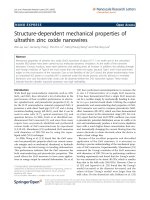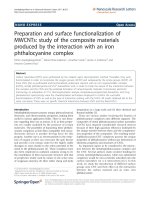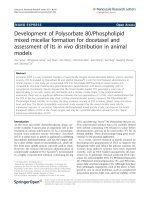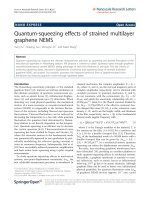Kato et al. Organic and Medicinal Chemistry Letters 2011, 1:7 pot
Bạn đang xem bản rút gọn của tài liệu. Xem và tải ngay bản đầy đủ của tài liệu tại đây (543.23 KB, 7 trang )
ORIGINAL Open Access
Synthesis and pharmacological characterization of
potent, selective, and orally bioavailable
isoindoline class dipeptidyl peptidase IV inhibitors
Noriyasu Kato
1*
, Mitsuru Oka
1
, Takayo Murase
1
, Masahiro Yoshida
1
, Masao Sakairi
1
, Mirensha Yakufu
3
,
Satoko Yamashita
1
, Yoshika Yasuda
1
, Aya Yoshikawa
2
, Yuji Hayashi
1
, Masahiro Shirai
1
, Yukie Mizuno
1
,
Mitsuaki Takeuchi
1
, Mitsuhiro Makino
1
, Motohiro Takeda
1
and Takuji Kakigami
2
Abstract
Focused structure-activity relationships of isoindoline class DPP-IV inhibitors have led to the discovery of 4b as a
highly selective, potent inhibitor of DPP-IV. In vivo studies in Wistar/ST rats showed that 4b was converted into the
strongly active metabolite 4l in high yield, resulting in good in vivo efficacy for antihyperglycemic activity.
1. Background
With the advent of sitagliptin (MK-0431) and vildaglip-
tin (LAF-237), doubt no longer exists regarding the
potential of dipeptidyl peptidase IV (DPP-IV; CD26; E.C.
3.4.14.5) inhibitors for the treatment of type 2 diabetes
[1-4]. Hence, intensive research efforts are being contin-
ued, and have led to the discovery of a number of
potent DPP-IV inhibitors (Figure 1) [5-9]. Research on
second-generation DPP-IV inhibitors has foc used on
selectivity for DPP-IV over o ther proline-specific dipep-
tidyl peptidases, especially DPP8/9, since it has been
suggested that inhibition of DDP-8/9 is associated with
severe toxicity [10,11]. In addition, the results of recent
clinical trials have indicated that prolonged and marked
inhibition of DPP-IV would be b eneficial for severely
diabetic patients [12,13]. The requirement for prolonged,
high exposure in humans imposes stringent r equire-
ments on the sa fety profiles and ADME pro perties of
back-up compounds. In this article, we describe our pre-
liminary results with potent and selective isoindoline
class DPP-IV inhibitors with respect to CYP, cyto-
chrome P450, induction, and rodent PK, studies as well
as inhibition of DPP-IV activity.
2. Results and discussion
Very recently, Jiaang and co-workers reported that proli-
nenitrile-based inhibitors with heterocyclic rings showed
high selectivity and potency for DPP-IV as well as in
vivo efficacy compared to vildagliptin [14]. We had also
pursued the possibility of isoindoline class DDP-IV inhi-
bitors and found their high potency and excellent in
vivo efficacy [15]. Thus, i soindolines were synthesized as
shown in Figure 1 and evaluated in vitro for their ability
to inhibit human recombinant DPP-IV and were also
screened for their selectivity over DPP-8/9 by a fluores-
cence assay using glycyl-proline 7-amino-4-methylcou-
marin (H-Gly-Pro-AMC). The inhibitory potency is
reported as the IC
50
value (Table 1). All the compounds
had excellent selectivity for DPP-IV over the other
related peptidases. Monosubstitution at positions around
the benzene ring of 4a was well tolerated, while re tain-
ing a high level of selectivity. Disubstitution, however,
led to a slight decrease in potency (4j, k). Disappoint-
ingly, most compounds showed CYP induction of either
or both of the two enzymes. Eventually, 4b was sub-
jected to further investigation.
In vivo PK studies on 4b showed a short plasma half-
life and reduced AUC w hen dosed intravenously (Table
2). Apparently, the reduction in AUC was partly due to
a very high clearance. On the other hand, oral adminis-
tration of 4b showed an improved half-life and a dose-
dependent increase in AUC. As it was estimated from
the PK profiles t hat 3-10 mg/kg doses of 4b would
* Correspondence:
1
Central Research Laboratory, Sanwa Kagaku Kenkyusho, Co., Ltd., 363
Shiosaki, Hokusei-cho, Inabe-city, Mie 511-0406, Japan
Full list of author information is available at the end of the article
Kato et al. Organic and Medicinal Chemistry Letters 2011, 1:7
/>© 2011 Kato et al; licens ee Springer. This is an Open Access article distributed under the terms of the Creative Commons Attribution
License ( which permits unrestricted use, distribution, and reproduction in any medium,
provided the original work is properly cited.
provide > 50% inhibition of DPP-IV for several hours,
we tried to briefly examine the potency of 4b in oral
glucose tolerance tests (OGTT).
Fasted male Wistar/ST rats received either vehicle or
4b at different oral doses (Figure 2). After 30 min (t =
0), oral glucose challenges (1 g/kg ) were conducted and
then plasma DPP-IV activities and blood glucose levels
were monitored at various intervals over a 2 h period.
Selected data are shown in Figure 2. To our surprise,
the1mg/kgdoseof4b resulted in 95% inhibition o f
plasma DPP-IV activity within 30 min post-dose and
inhibiti on of greater than 90% was maintained through-
out the study. The inhibitory effect was dose-dependent,
and even the 0.1 mg/kg dose produced 30% inhibition.
Similarly, reduction of glucose levels paralleled DPP-IV
inhibition and a reduction of 18% was observed at a
Figure 1 Some gliptins and isoindoline class DPP-4 inhibitors.
Table 1 Inhibition of DPP-IV, -8 and -9 activity by 1,3-dihydroisoindoline derivatives 4, their metabolic clearance by
rat and human and their enzyme-inducing (CYP1A, CYP2B, and CYP3A) capacity
Compound 4 R IC
50
(nM) CL’int (L/h/Kg) Enzyme induction (rat)
DPP-IV DPP8 DPP9 Rat Human CYP1A CYP2B CYP3A
a -H 2.3 > 100,000 > 100,000 1.3 0.2 + + +
b 5-Me 3.4 (28)
c
59,000 > 100,000 2.3 0.1 - - -
c 5-F 1.9 > 100,000 > 100,000 2.6 4.8 - + N.T.
b
d 5-Br 3.0 36,000 > 100,000 N.T.
b
N.T.
b
- + N.T.
b
e 5-Cl 4.8 44,000 > 100,000 N.T.
b
N.T.
b
- + N.T.
b
f 5-CF
3
5.4 > 100,000 > 100,000 N.T.
b
N.T.
b
+ + N.T.
b
g 4-F 2.6 > 100,000 > 100,000 N.T.
b
N.T.
b
- + N.T.
b
h 4-Me 4.0 > 100,000 > 100,000 N.T.
b
N.T.
b
- + N.T.
b
i 4,7-diCl 2.6 > 100,000 > 100,000 N.T.
b
N.T.
b
+ - N.T.
b
j 5,6-diCl 22 > 100,000 74,000 N.T.
b
N.T.
b
+ + N.T.
b
k 4-MeO-6-Me 16 > 100,000 > 100,000 N.T.
b
N.T.
b
- + N.T.
b
l 5-CH
2
OH 1.9
a
N.T.
b
N.T.
b
N.T.
b
N.T.
b
- - N.T.
b
a
IC
50
determined with respect to human plasma DPP-IV in separate experiments.
b
Not tested.
Kato et al. Organic and Medicinal Chemistry Letters 2011, 1:7
/>Page 2 of 7
dose of 1 mg/kg. In addition, increased insulin levels at
10 min post-challenge strongly suggested preservation
of active GLP-1.
The high clearance of 4b suggested that the unex-
pected in vivo efficacy might be explained by the pre-
sence of active metabolites. Therefore, further PK
studies were conducted. A major metabolite was
detected by LC-MS analysis and its structure was
determined by comparison of the LC retention time
and MS/MS fragmentation pattern with synthetic stan-
dards. Consequently, 4l wasidentifiedasaveryactive
metabolite, which showed a reasonable degree of sys-
temic exposure by virtue of in vivo conversion as high
as 60%.
3. Conclusions
In summary, the focused, small SARs of the isoindoline
derivatives have led to the discovery of 4b as a highly
selective, potent inhibitor of DPP-IV. The in vivo studies
showed that the active metabolite 4l had a very high
inhibitory potency with respect to DPP-IV. Conse-
quently, we abandoned f urther development of com-
pounds in this series. However, on the basis of the
results described here, we found anagliptin, which has
advanced into PIII trials, to have improved safety pro-
files and PK parameters. This article is also intended to
provide information on the scope and limitations of iso-
indoline-based DPP-IV inhibitors and to facilitate
research on the new generation DPP-IV inhibitors.
Table 2 PK parameters of 4b in SD rats
Route Dose
(mg/kg)
t
1/2a
(h)
t
1/2a
(h)
Vd
ss
(L/kg)
CL
p
(L/h/kg)
C
max
(ng/mL)
T
max
(h)
AUC
0-9 h
(ng h/mL)
BA
(%)
Iv 1 0.062 0.27 8.28 26.2 ND ND 39
po 3 ND 1.37 ND ND 37 0.25 33 27.7
10 ND 1.50 ND ND 229 0.25 156 39.9
Figure 2 Pharmacological data on 4b.Topleft,plasmaDPP-IVactivity(%changefrom-30 min value) in Wistar/ST rats. Data are given as
mean ± SEM (n = 7). Top right, plasma insulin (pg/dL) at 10 min after glucose challenge in Wistar/ST rats. Data are given as mean ± SEM (n =
7). Bottom left, blood glucose during OGTT in Wistar/ST rats. Data are given as mean ± SEM (n = 7). Asterisks indicate significance from vehicle
control at p < 0.05 (*) and p < 0.01 (**) by Dunnett’s test. Bottom right, blood glucose AUC (mg min/dL) determined between 0 and 60 min
during OGTT in Wistar/ST rats. Data are given as mean ± SEM (n = 7). **Significant difference from vehicle control by Dunnett’s test (p < 0.01).
Kato et al. Organic and Medicinal Chemistry Letters 2011, 1:7
/>Page 3 of 7
4. Methods
4.1. Compound synthesis
4.1.1. General
All commercially available reagents and solvents were
used as-received. All reactions were carried out u sing
oven-dried flasks or glassware, and mixtures were stir-
red with stirring bars and concentrated using a stan-
dard rotary evaporator unless otherwise noted.
Procedures for preparation of all intermediates 2 and 3
were describ ed previously [15]. The
1
HNMRspectra
were recorded by a JEOL JNM-ECP400 spectrometer
operating at 400 MHz in DMSO-d
6
at 25°C with tetra-
methylsilane as the internal standard. The data are
reported as follows: chemical shift in ppm (δ), integra-
tion, multiplicity (s = singlet, d = doublet, t = triplet, q
= quartet, br = broad singlet, m = multiplet), and cou-
pling constant (Hz). LC/MS spectra were determined
on a Waters ZMD2000 equipped with a Waters 2690
injector and a PDA detector operating at 210-400 nm
and interfaced with a Micromass ZMD mass
spectrometer.
4.1.2. Representative procedure for preparation of
pyrrolidine carbonitrile 4; (S)-1-(2-(4-(Isoindolin-2-yl)-2-
methyl-4-oxobutan-2-ylamino)acetyl)pyrrolidine-2-
carbonitrile HCl Salt (4a)
Asolutionof(S)-1-(2-chloroacetyl)pyrrolidine-2-carbo-
nitrile (467 mg, 2.70 mmol) in acetone (5.0 mL) was
added drop-by-drop to an ice-cooled stirred suspension
of 3a (550 mg, 2.50 mmol), K
2
CO
3
(370 mg, 2.70
mmol), and NaI (200 mg, 1.30 mmol) in acetone (20
mL). The reaction mixture was stirred at room tempera-
ture overnight. The resulting mixture was filtered to
remove insoluble materials, and concentrated under
reduced pressure. The residue was purified by column
chromatography on silica gel (CH
2
Cl
2
/MeOH = 20/1) to
give 540 mg (61%) of 4a of the free base. To an ice-
cooled solution of 4a ofthefreebase(250mg,0.70
mmol), 1,4-dioxane (5.0 mL) was added 4N-HCl/1,4-
dioxane (180 μL, 0.72 mmol). The reaction mixture was
stirred at 0°C for 1 h and then evaporated to yield the
title compound (240 mg, Y. 88%).
1
H NMR 1.38 (6H, s),
2.00-2.22 (4H, m), 2.85-2. 90 (2H, m), 3.30-4.10 (4H, m),
4.69 (2H, s), 4.87 (2H, s), 4.80-4.85 (1H, m), 7.25-7.40
(4H, m); MS m/z 355 (M+H)
+
.
4.1.3. (S)-1-(2-(2-Methyl-4-(5-methylisoindolin-2-yl)-4-
oxobutan-2-ylamino)acetyl)pyrrolidine-2-carbonitrile HCl
Salt (4b)
Colorless solid (92%).
1
H NMR 1.41 (6H, s), 1.99-2.11
(2H, m), 2.18-2.24 (2H, m), 2,32 (3H, s), 2.88-2.98
(2H, m), 3.21-3.39 (2H, m), 3.50-3.57 (1H, m), 3.68-
3.72 (1H, m), 4.06-4.10 (1H, m), 4.66 (2H, s), 4.86
(2H, sm), 7.13-7.28 (3H, m), 9.29 (2H, brs); MS m/z
369 (M+H)
+
.
4.1.4. (S)-1-(2-(4-(5-Fluoroisoindolin-2-yl)-2-methyl-4-
oxobutan-2-ylamino)acetyl)pyrrolidine-2-carbonitrile HCl
Salt (4c)
Colorless solid (31%).
1
H NMR 1.40 (6H, s), 2.02-2.08
(2H, m), 2. 19-2.22 (2H, m), 2.88-2.89 (2H, m), 3.50-3.69
(2H, m), 4. 04-4.07 (2H, m), 4.67-4.70 (2H, m), 4.85-4.89
(3H, m), 7.16 (1H, t, J = 9.2 Hz), 7.24 (1H, t, J =9.2
Hz), 7.37-7.44 (1H, m), 9.10 (2H, brs); MS m/z 373 (M
+H)
+
.
4.1.5. (S)-1-(2-(4-(5-Bromoisoindolin-2-yl)-2-methyl-4-
oxobutan-2-ylamino)acetyl)pyrrolidine-2-carbonitrile HCl
Salt (4d)
Colorless solid (81%).
1
H NMR 1.35 (6H, s), 1.95-2.05
(2H, m), 2.12-2.18 (2H, m), 2.83 (2H, s) 3.70-4.05 (4H,
m), 4.62-4.72 (2H, m), 4.78-4.84 (3H, m), 7.29-7.60 (3H,
m), 8.21 (2H, brs); MS m/z 423 (M+H)
+
.
4.1.6. (S)-1-(2-(4-(5-Chloroisoindolin-2-yl)-2-methyl-4-
oxobutan-2-ylamino)acetyl)pyrrolidine-2-carbonitrile HCl
salt (4e)
Colorless solid (38%).
1
H NMR 1.65 (6H, s), 2.20-2.35
(4H, m), 2. 90-3.35 (2H, m), 3.70-4.40 (4H, m), 4.75-5.00
(5H, m), 7.20-7.30 (3H, m); MS m/z 389 (M+H)
+
.
4.1.7. (S)-1-(2-(2-Methyl-4-oxo-4-(5-(trifluoromethyl)
isoindolin-2-yl)butan-2-ylamino)acetyl)pyrrolidine-2-
carbonitrile HCl salt (4f)
Colorless solid (37%).
1
H NMR 1.41 (6H, s), 1.98-2.09
(2H, m), 2.18-2.25 (2H, m), 2.92 (2H, d, J =3.3Hz),
3.50-3.54 (1H, m), 3.67-3. 72 (1H, m), 4.00-4.13 (2H, m),
4.78 (2H, s), 4.87 (1H, dd, J = 3. 3 and 7.3 Hz), 4.97 (2 H,
s), 7.59-7.64 (1H, m), 7.69 (1H, d, J = 8.1 Hz), 7.76-7.80
(1H, m), 9.19 (2H, brs); MS m/z 423 (M+H)
+
.
4.1.8. (S)-1-(2-(4-(4-Fluoroisoindolin-2-yl)-2-methyl-4-
oxobutan-2-ylamino)acetyl)pyrrolidine-2-carbonitrile HCl
salt (4g)
Colorless solid (23%).
1
H NMR 1.40 (6H, s), 2.01-2.09
(2H, m), 2. 18-2.25 (2H, m), 2.92-2.94 (2H, m), 3.51-3.53
(1H, m), 3.66-3 .72 (1H, m), 4.00-4.13 (2H, m), 4.75 (2H,
s), 4.85-4.87 (1H, m), 4.97 (1H, s), 7.16 (1H, t, J =8.8
Hz), 7.21-7.25 (1H, m), 7.37-7.43 (1H, m), 9.18 (2H,
brs); MS m/z 373 (M+H)
+
.
4.1.9. (S)-1-(2-(2-Methyl-4-(4-methylisoindolin-2-yl)-4-
oxobutan-2-ylamino)acetyl)pyrrolidine-2-carbonitrile HCl
salt (4h)
Colorless solid (33%).
1
H NMR 1.41 (6H, s), 2.03-2.11
(2H, m), 2.17-2.24 (2H, m), 2.26 (3H, s), 2.95 (2H, d, J =
8.9 Hz), (2H, m), 3.40-3.66 (2H, m), 3.97-4.10 (2H, m),
4.25-4.31 (1H, m), 4.68 (2H, s), 4.88 (2H, s), 7.11-7.25
(3H, m), 9.29 (2H, brs); MS m/z 369 (M+H)
+
.
4.1.10. (S)-1-(2-(4-(4,7-Dichloroisoindolin-2-yl)-2-methyl-4-
oxobutan-2-ylamino)acetyl)pyrrolidine-2-carbonitrile HCl
salt (4i)
Colorless solid (69%).
1
H NMR 1.41 (6H, s), 2.03-2.10
(2H, m), 2. 19-2.25 (2H, m), 2.94-2.97 (2H, m), 3.67-3.72
Kato et al. Organic and Medicinal Chemistry Letters 2011, 1:7
/>Page 4 of 7
(2H, m), 4.03-4.14 (2H, m), 4.77 (2H, s), 4.86(1H, dd, J =
4.4 and 7.3 Hz), 5.00 (2H, s), 7.48 (2H, s), 9.18 (2H, brs);
MS m/z 423 (M+H)
+
.
4.1.11. (S)-1-(2-(4-(5,6-Dichloroisoindolin-2-yl)-2-methyl-4-
oxobutan-2-ylamino)acetyl)pyrrolidine-2-carbonitrile HCl
salt (4j)
Colorless solid (10%).
1
H NMR 1.65 (6H, s), 2.20-2.35
(4H, m), 2. 90-3.35 (2H, m), 3.70-4.40 (4H, m), 4.80-4.95
(5H, m), 7.37-7.44 (2H, m); MS m/z 423 (M+H)
+
.
4.1.12. (S)-1-(2-(4-(4-Methoxy-6-methylisoindolin-2-yl)-2-
methyl-4-oxobutan-2-ylamino)acetyl)pyrrolidine-2-
carbonitrile HCl salt (4k)
Colorless solid (77%).
1
H NMR 1.55-1.70 (6H, m), 2.20-
2.35 (4H, m), 2.37 (3H, s), 2.80-3.40 ( 2H, m), 3.60-4.45
(7H, m), 4.65-4.90 (5H, m), 6.55-6.75 (2H, m); MS m/z
399 (M+H)
+
.
4.1.13. (S)-1-(2-(4-(5-(Hydroxymethyl)isoindolin-2-yl)-2-
methyl-4-oxobutan-2-ylamino)acetyl)pyrrolidine-2-
carbonitrile HCl salt (4l)
Colorless solid (81%).
1
H NMR 1.41 (6H, s), 2.0-2.25
(4H, m), 2.92 (2H, m), 3.5-4.1 (4H, m), 4.5-4.9 (7H, m),
7.2-7.4 (3H, m), 9.28 (2H, brs); MS m/z 385 (M+H)
+
.
4.2. Biological evaluation
4.2.1. In vitro assay for DPP-IV inhibition
Inhibition o f DPP-IV activity was determined by mea-
suring the rate of hydrolysis of a surrogate substrate, H-
Gly-Pro-7-amino-4-methylcoumarin (H-Gly-Pro-AMC).
Human recombinant DPP-IV was purchased from R&D
Systems, Minneapolis, MN. 10 μL of appropriately
diluted solutions of the test compounds in water was
added to 96-well microtiter plates, followed by the addi-
tion of 40 μL of DPP-IV diluted in assay buffer (25 mM
HEPES, 140 mM NaC1, 0.1 mg/mL BSA, pH 7.8). After
a 30-min preincubation at room temperature, the reac-
tion was initiated by the addition of 50 μL of the assay
buffer containing 0.2 mM H-Gly-Pro-AMC. After incu-
bation at room temperature for 20 min, the reaction
was stopped by the addit ion of 100 μLof25%aqueous
acetic acid and fluorescence was measured using a n
excitation wavelength of 390 nm and an emissi on wave-
length of 460 nm. A standard curve for AMC was gen-
erated by adding 0.2-20 μmol of AMC to buffer
solutions containing 12.5% aqueous acetic acid. The
inhibitory rate relative to the control without inhibitor
was calculated and IC
50
values wer e determined by non-
linear regression (GraphPad Prism 4, ver. 4.03 software).
4.2.2 In vitro assays for inhibition of DPP-8 and DPP-9
Human DPP-8 and DPP-9 were expressed in baculo-
virus-infected Sf9 insect cells and purified using His-
tagged pr otein purification resins. Inhibition of DPP-8
and -9 activities was determined as described above. 10
μL of appropriately diluted aqueous solutions of the test
compounds was adde d to 96-well microtiter pl ates,
followed by the addition of 50 μLof1.0mMH-Gly-
Pro-AMC in buffer solution (50 mM HEPES, 0.1 mg/
mL BSA, pH 8.0). The reaction was initiated by the
addition of 40 μL of the enzyme so lution diluted in the
assay b uffer. After incubation at room temperature for
30 min, the reaction was stopped by the addition of 100
μL of 25% aqueous acetic acid and fluorescence was
measured using an excitation wavelength of 390 nm and
an emission wavelength of 460 nm.
4.2.3. In vivo assay methods
All procedures were approved by the Sanwa Kagaku
Kenkyusho Institutio nal Animal Care an d Use Commit-
tee. 7-week old Wistar/ST rats were housed under stan-
dard conditions and allowed free access to water and a
commercial diet for at least 5 days. The rats were fasted
overnight prior to dosing and then received 4b orally at
doses of 0.1-1 mg/kg or vehicle as a 5 mL/kg aqueous
solution 30 min before glucose challenge. After an oral
glucose challenge (5 mL/kg of an aqueous solution of
20% glucose), blood samples were collected from the tail
vein of each animal into heparin-containing t ubes at
serial time points for 2 h. Plasma was prepared immedi-
ately, frozen, and stored at -20°C prior to analysis.
4.2.4 Inhibition of rat plasma DPP-IV ex vivo
Plasma DPP-IV activity w as determined as described
above. A 20 μL plasma sample was mixed with 5 μLof
reaction buffer (140 mM NaCl, and 10 mM KCl, 25
mM Tris-HCl, pH 7.4, 1% bovine serum albumin) and
10 μL of buffer containing 60 μM H-Gly-Pro-AMC.
After incubation at room t emperature for 30 m in, the
reaction was stopped by the addition of 20 μLof25%
aqueous acetic acid and fluorescence was measured
using an excitation wavelength of 360 nm and an emis -
sion wavelength of 460 nm.
4.2.5 Measurement of plasma glucose and insulin
concentrations
Plasma glucose and insulin were determined with a
glucometer (Glutest Pro; SKK, Japan) and a rat insulin
ELISA kit (Shibayagi, Japan), respectively, according to
the manufactur er’s instructio ns. Statistical analys es were
performed using Microsoft Excel. Individual compari-
sons among more than two experimental groups were
assessed using ANOVA, with Fisher’s Least Significant
Difference post hoc test. Differences were considered
significant at P values < 0.05. Analysis of dose-response
data was performed by Dunnett ’s test.
4.2.6 Pharmacokinetics (PK) in rats
Sprague-Dawley (SD) rats were housed under standard
conditions and allowed free access to water and a com-
mercial diet. On the day befo re the experiment, rats
were fasted overnight and for the first 12 h of the
experiment. Compounds 4b were prepared in a saline/
ethanol vehicle (50/50 v/v) at appropriate concentrations
of 4b as an intravenous (iv) injection of 1 mL/kg via the
Kato et al. Organic and Medicinal Chemistry Letters 2011, 1:7
/>Page 5 of 7
femoral vein and as a suspension in 5% gum arabic solu-
tion for o ral (po) administration. Blo od samples were
collected from the jugular vein of each animal with a
heparinized syringe under diethyl ether anesthesia at
serial time points for 24 h after drug administration.
Plasma was obtained by centrifugation at 4°C and stored
at -70°C until analysis. Protein precipitation was carried
out by the addition of the internal standard solution
(70% CH
3
CN with 0.2% acetic acid) to samples. The
tubes underwent vigorous shaking and centrifugation for
5 min; then t he supernatant was subjected to LC/MS/
MS analysis. Peak areas were determined using Xcali-
bur
®
software (Thermo Electron Corporation, UK) and
AUC values were calculated by the trapezoidal rule.
4.3. Metabolic stability
The incubation mixture containing 0.25 mg of rat or
human l iver microsome s was preincubated with an
NADPH-generating system for 5 min at 37°C. The reac-
tion was started by the addition of 5 μLofaDMSO
solution containing the test compound (5 μM). At t =0
and at two additional time points between 0 and 30
min, aliquots (100 μL) were removed and added to ter-
mination mixtures (CH
3
CN). Prot eins were sedimented
by centrifugation and an aliquot of the supernatant was
analyzed by LC/MS/MS.
In determinations of the in vitrot
1/2
, the analyte/ISTD
peak area ratio was converted to percentage of drug
remaining by assigning a value of 100% to the peak area
ratio at t = 0. The slope of the regression line fitted to
the log (percentage remaining) versus incubation time
relationship (-k) was used in the conversion of raw data
to the in vitrot
1/2
value. In vitro CL
int
was calculated
using the following formula.
CL
int
=
0.693
In vitro t
1
/
2
×
mL incubation
mg microsomes
×
45 mg microsomes
mg liver
×
20 mg live
r
kg (b.w.)
Enzyme induction was evaluated as follows: Hepato-
cytes isolated from male SD rats w ere maintained in
culture for 1 day before treatment with the test com-
pound or P-450 inducers. The cells were treated with
the test compound (1, 10, 50 μM), b-naphthoflavone (10
μM, CYP1A inducer), phenobarbital (50 μM, CYP2B
inducer), dexamethasone (10 μM, CYP3A inducer), or
vehicle (0.1% DMSO final volume; used as negative con-
trol) for 2 days.
Induction of CYP1A, CYP2B, and CYP3A enzymes
was determined based on measurements of 7-ethoxyre-
sorufin O-dealkylation, 7-pentoxyresorufin O-dealkyla-
tion, and t estosterone 6b-hydroxylation, respectively.
Assays were started by the addition of Krebs-Henseleit
buffer containing 8 μM 7-ethoxyresorufin, 10 μM 7-pen-
toxyresorufin, or 250 μM testosterone at a volume of
100 μL per well. After incubation at 37°C for 30 min,
ali quots were removed and analyzed by fluorometry (an
excitation wavelength of 538 nm and an emission wave-
length of 590 nm) or LC/MS/MS to determine the
quantities of metabolites formed. Any test compound
causing a dose-dependent change equal to or greater
than 10% of the positive control (see formula below)
was considered an enzyme inducer.
% positive control =
(activity of test - compound treated cells - activity of negative control)
(
activity of positive control - activity of negative control
)
×10
0
Author details
1
Central Research Laboratory, Sanwa Kagaku Kenkyusho, Co., Ltd., 363
Shiosaki, Hokusei-cho, Inabe-city, Mie 511-0406, Japan
2
Sanwa Kagaku
Kenkyusho, Co., Ltd., 35 Higashisotobori-cho, Higashi-ku, Nagoya 461-8631,
Japan
3
Xinjiang Medical University, Urumqi 830011, China
Competing interests
The authors declare that they have no competing interests.
Received: 22 June 2011 Accepted: 12 September 2011
Published: 12 September 2011
References
1. Ahre’n B (2007) Dipeptidyl peptidase-4 inhibitors: clinical data and clinical
implications. Diabetes Care 30(5):1344–1350
2. Aschner P, Kipnes MS, Lunceford JK, Sanchez M, Mickel C, Williams-
Herman ED (2006) Effect of the Dipeptidyl peptidase-4 inhibitor sitagliptin
as monotherapy on glycemic control in patients with type 2 diabetes.
Diabetes Care 29(12):2632–2637. doi:10.2337/dc06-0703.
3. Bosi E, Camisasca RP, Collober C, Rochotte E, Garber AJ (2007) Effects of
vildagliptin on glucose control over 24 weeks in patients with type 2
diabetes inadequately controlled with metformin. Diabetes Care
30(4):890–895. doi:10.2337/dc06-1732.
4. Rosenstock J, Barron MA, Dejager S, Mills D, Schweizer A (2007) Comparison
of vildagliptin and rosiglitazone monotherapy in patients with type 2
diabetes: a 24-week, double-blind, randomized trial. Diabetes Care
30(2):217–223. doi:10.2337/dc06-1815.
5. Drucker DJ (2003) Enhancing incretin action for the treatment of type 2
diabetes. Diabetes Care 26(10):2929–2940. doi:10.2337/diacare.26.10.2929.
6. Gwaltney SL II, Stafford JA (2005) Inhibitors of dipeptidyl peptidase 4. Annu
Rep Med Chem 40:149–165
7. Havale SH, Pal M (2009) Medicinal chemistry approaches to the inhibition
of dipeptidyl peptidase-4 for the treatment of type 2 diabetes. Bioorg Med
Chem 17(5):1783–1802. doi:10.1016/j.bmc.2009.01.061.
8. Villhauer EB, Coppola GM, Hughes TE (2001) DPP-IV inhibition and
therapeutic potential. Ann Reports Med Chem 36:191–200
9. Weber AE (2004) Dipeptidyl peptidase IV inhibitors for the treatment of
diabetes. J Med Chem 47(17):4135–4141. doi:10.1021/jm030628v.
10. Lankas GR, Leiting B, Roy RS, Eiermann GJ, Beconi MG, Biftu T, Chan CC,
Edmondson S, Feeney WP, He H, Ippolito DE, Kim D, Lyons KA, Ok HO,
Patel RA, Petrov AN, Pryor KA, Qian X, Reigle L, Woods A, Wu JK, Zaller D,
Zhang X, Zhu L, Weber AE, Thornberry N (2005) Dipeptidyl peptidase IV
inhibition for the treatment of type 2 diabetes: potential importance of
selectivity over dipeptidyl peptidases 8 and 9. Diabetes 54(10):2988–2994.
doi:10.2337/diabetes.54.10.2988.
11. Šedo A, Malik R (2001) Dipeptidyl peptidase IV-like molecules: homologous
proteins or homologous activities? Biochim Biophys Acta 1550:107–116.
doi:10.1016/S0167-4838(01)00278-3.
12. Ahre’n B, Simonsson E, Larsson H, Landin-Olsson M, Torgeirsson H,
Jansson P-A, Sandqvist M, Bavenholm P, Efendic S, Eriksson JW, Dickinson S,
Holmes D (2002) Inhibition of dipeptidyl peptidase IV improves metabolic
control over a 4-week study period in type 2 diabetes. Diabetes Care
25(5):869–875. doi:10.2337/diacare.25.5.869.
13. Ahre’n B, Gomis R, Standl E, Mills D, Schweizer A (2004) Twelve- and 52-
week efficacy of the dipeptidyl peptidase IV inhibitor LAF237 in metformin-
Kato et al. Organic and Medicinal Chemistry Letters 2011, 1:7
/>Page 6 of 7
treated patients with type 2 diabetes. Diabetes Care 27(12):2874–2880.
doi:10.2337/diacare.27.12.2874.
14. Tsu H, Chen X, Chen CT, Lee SJ, Chang CN, Kao KH, Coumar MS, Yeh YT,
Chien CH, Wang HS, Lin KT, Chang YY, Wu SH, Chen YS, Lu IL, Wu SY,
Tsai TY, Chen WC, Hsieh HP, Chao YS, Jiaang WT (2006) 2-[3-[2-[(2S)-2-
Cyano-1-pyrrolidinyl]-2-oxoethylamino]-3-methyl-1-oxobutyl]-1,2,3,4-
tetrahydroisoquinoline: a potent, selective, and orally bioavailable dipeptide-
derived inhibitor of dipeptidyl peptidase IV. J Med Chem 49(1):373–380.
doi:10.1021/jm0507781.
15. Kakigami T, Oka M, Katoh N, Yoshida M, Shirai M, Murase T, Sakairi M,
Yamamoto T, Takeuchi M, Hayashi Y, Takeda M, Makino M (2004)
Compound inhibiting dideptidyl peptidase IV. Chem Abstr 141:190794.
WO04/067509
doi:10.1186/2191-2858-1-7
Cite this article as: Kato et al.: Synthesis and pharmacological
characterization of potent, selective, and orally bioavailable isoindoline
class dipeptidyl peptidase IV inhibitors. Organic and Medicinal Chemistry
Letters 2011 1:7.
Submit your manuscript to a
journal and benefi t from:
7 Convenient online submission
7 Rigorous peer review
7 Immediate publication on acceptance
7 Open access: articles freely available online
7 High visibility within the fi eld
7 Retaining the copyright to your article
Submit your next manuscript at 7 springeropen.com
Kato et al. Organic and Medicinal Chemistry Letters 2011, 1:7
/>Page 7 of 7









